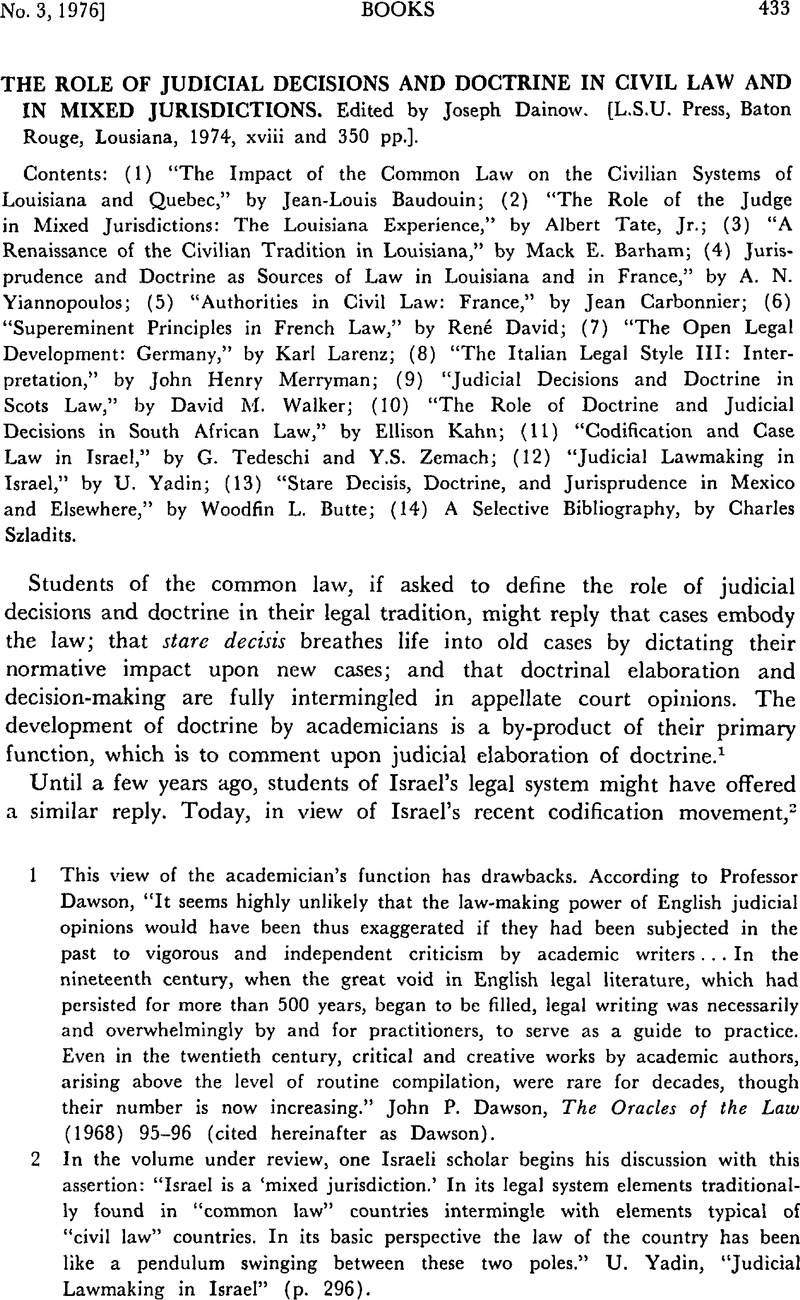No CrossRef data available.
Article contents
The Role of Judicial Decisions and Doctrine in Civil Law and in Mixed Jurisdictions. Edited by Joseph Dainow. [L.S.U. Press, Baton Rouge, Lousiana, 1974, xviii and 350 pp.].
Published online by Cambridge University Press: 12 February 2016
Abstract

- Type
- Books
- Information
- Copyright
- Copyright © Cambridge University Press and The Faculty of Law, The Hebrew University of Jerusalem 1976
References
1 This view of the academician's function has drawbacks. According to Professor Dawson, “It seems highly unlikely that the law-making power of English judicial opinions would have been thus exaggerated if they had been subjected in the past to vigorous and independent criticism by academic writers … In the nineteenth century, when the great void in English legal literature, which had persisted for more than 500 years, began to be filled, legal writing was necessarily and overwhelmingly by and for practitioners, to serve as a guide to practice. Even in the twentieth century, critical and creative works by academic authors, arising above the level of routine compilation, were rare for decades, though their number is now increasing.” Dawson, John P., The Oracles of the Law (1968) 95–96Google Scholar (cited hereinafter as Dawson).
2 In the volume under review, one Israeli scholar begins his discussion with this assertion: “Israel is a ‘mixed jurisdiction.’ In its legal system elements traditionally found in “common law” countries intermingle with elements typical of “civil law” countries. In its basic perspective the law of the country has been like a pendulum swinging between these two poles.” U. Yadin, “Judicial Lawmaking in Israel” (p. 296).
3 Dawson, at p. xiii.
4 See Merryman, J.H., The Civil Law Tradition (1969) 16–17Google Scholar (cited hereafter as Merryman). For a more detailed discussion of the impact of the separation-of-powers-doctrine upon Italy, see Merryman, “The Italian Legal Style III: Interpretation” (pp. 163–201).
5 In civil law systems the term “jurisprudence” is synonymous with judicial decisions. Whether judicial decisions constitute case law is integral to the debate.
6 The battle-cry “Que Dieu nous garde de l'equité des Parlements” (God save us from the equity of the pre-revolutionary courts) reflects this distrust. J.L. Baudouin, “The Impact of the Common Law on the Civilian Systems of Louisiana and Quebec” (pp. 7–8).
7 Merryman, at p. 16.
8 Dawson, at pp. 392–395.
9 See supra n. 6.
10 For another view of the roles of jurisprudence and doctrine, see Esmein, A., “La Jurisprudence et la Doctrine” (1902) 1 Rev. Trim, de Droit Civil 5Google Scholar, translated in Herman, , “Excerpts from a Discourse on the Code Napoleon by Portalis, and Case Law and Doctrine by A. Esmein” (1972) 18 Loyola L. Rev. 23.Google Scholar See also Dawson at pp. 399–400.
11 David actually hedges on the role of jurisprudence, for the reader would naturally ask if there can be an “untrue” source of law. Elsewhere David acknowledges that jurisprudence is a source of law subordinate to legislation and custom. But adherence to the doctrine of separation of powers forces the judge to hide his creative role behind the screen of “legislative interpretation”. David, R. and Brierley, J.E.C., Major Legal Systems in the World Today (1968) 104.Google Scholar
12 Such as fraus omnia corrumpit (fraud spoils everything), unjust enrichment, abuse of rights, and public order.
13 Dawson's discussion of Bülow is especially relevant. Dawson at pp. 443–444.
14 Professor Dawson's masterly treatment of Germany's commitment to legal science and Germany's case law revolution renders extensive historical elaboration unnecessary for this review. See Dawson, at pp. 148–262 and 432–502.
15 Painstakingly translated by ProfessorWallach, Kate from Methodenlehre der Rechtswissenschaft (Methodology of Legal Science) (2nd ed., 1969).Google Scholar
16 Larenz cites the doctrine of culpa in contrahendo as judicial creation. “It cannot be deduced from the code unless, perhaps, by total analogy.” (p. 142).
17 The German tendency to sacrifice certainty for workability has a host of critics who argue that the German judges “had agressively opted for judicial discretion at the expense of certainty in the 1920's, both to justify their use of general clauses and to follow the theory advanced by the free law school of jurists. The Italian judges stayed with their traditional approach of emphasizing certainty and exercising only a very limited degree of discretion. When darkness fell, the German judges were unable to defend the legal order by calling on the importance of certainty. Unlike the Italians, they had openly abandoned that principle.” Merryman, at p. 56.
18 “A generic term for those who wrote general, wide-ranging books … in imitation of Gaius and Justinian…” (p. 215).
19 Having designated custom a source of law, Professor Yiannopoulos tries to reduce the tension by equating jurisprudence constante with a form of customary law. This is Gény's view. See Gény, , Methode d'interpretation et Sources en Droit Privé Positif (1919) vol. 1, pp. 209–211 and vol. 2, pp. 33–53Google Scholar, translated in Gény, , Method of Interpretation and Sources of Private Positive Law § 85 and §§ 146–149 (Louisiana State Law Institute Translation, 1963).Google Scholar For scholarly criticism of Gény's view, and of Yiannopoulos's view by implication, see Dawson, at pp. 417–424 and citations therein.
20 Justice Barham's “A Renaissance of the Civilian Tradition in Louisiana”, which openly relies upon Merryman's distinction between folklore and practice, also reinforces Justice Tate's portrait of the Louisiana judge (pp. 38–68).
21 See text supra at n. 8.
22 Professor Carbonnier's essay includes a good exposition of the civil law techniques of interpretation (pp. 112–116).
23 This is Professor Yadin's phrase (p. 299).




